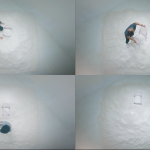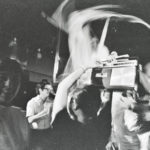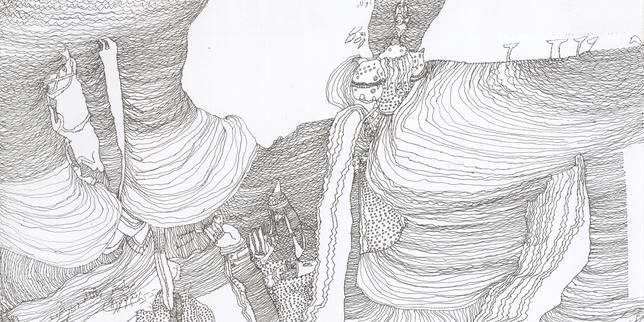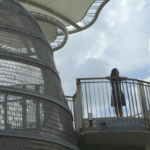Zwillinge
2017 - Sculpture (Sculpture)
91 x 90 x 11.8 cm
Vaclav Pozarek
Concerning his objects, Pozarek often relies on chance to guide him. He uses scraps of wood, boxes, hinges and doors, keeping a close eye on what position each object will assume later in the space. Although it suggests the opposite at first glance, Zwillinge is autonomous and functionless. Assembled from found wood and aluminium, and making use of empty and in-between space, it makes a quasi-serious impression, as if they have an important task to fulfill. As part of an ensemble, these objects become actors that play specific roles that can change depending on the constellation. With the specific installation of this work, the gallery’s architecture is accentuated as a frame of reference. Pozarek’s working method is anything but capricious, dreamy, or playful. He works with a target in mind, even though the formal theme of his work first emerges when he is modelling the materials.
Growing up in Czechoslovakia, Vaclav Pozarek experienced political aggression, spying and ludicrous impediments. For a long time, he was denied of almost everything; the only remaining thing allowed was for him to become a toolmaker. However, later he found work as a typographer in Pilsen. There was the official doctrine of Socialist Realism, but the fact that the art should serve a political purpose was, for Pozarek, off the cards. In 1968 he left, first to Hamburg and London, where he studied under Anthony Caro at Central Saint Martin’s School of Art, before settling in Bern. In Bern, Pozarek developed a synthesis of the Constructivist principles and the application of the arts to everyday reality. Pozarek’s practice traverses predominantly sculpture and drawing, while also incorporating installations, photography, and film.
Colors:
Related works sharing similar palette

© » KADIST
Eileen Quinlan
2016Eileen Quinlan’s abstracted images, like Swipe , rely on the manipulation of photographic materials inside the studio itself, and reject the exterior world for complex interrogations of the medium....

© » KADIST
Gala Porras-Kim
2017The graphite drawing 4 mourners on a mantel by Gala Porras-Kim is part of a larger installation and body of research, entitled An Index and Its Settings (Un Índice y Sus Entornos) , in which the artist reconsiders 235 ancient burial figures (from circa 200 BCE – 50 CE) from what is now Mexico’s Pacific coast that are part of the Proctor Stafford Collection held by the Los Angeles County Museum of Art (LACMA)...

© » KADIST
Judith Hopf
2018Hopf’s works reference the effects that developments in economics and technology have had on our bodily and mental composition...

© » KADIST
Juan Obando
2023They/Them by Juan Obando is a video essay and deepfake that uses Adobe Stock clips, maintaining their branded watermark, but animating the scenes underneath with a narrative of self-critical awareness...

© » KADIST
Roman Ondak
2003As the caption purposely admits, these drawings were made by friends of Ondák’s at home in Slovakia asked to interpret places he has journeyed to...

© » KADIST
Reza Aramesh
2016The photographed plaster heads set against the idyllic landscapes of the south of England, subvert the process of image production and memory...

© » ARTS EQUATOR
BIPAM 2021: Delight, despair, dialogue and the despot | ArtsEquator Thinking and Talking about Arts and Culture in Southeast Asia ArtsEquator Viewpoints September 17, 2021 By Nabilah Said (1,800 words, 6-minute read) I’ve never actually attended the Bangkok International Performing Arts Meeting (BIPAM)...

© » KADIST
Mary Reid Kelley
2015Kelley’s 2015 portrait of the poet Charles Baudelaire is one of a series of poets, rappers, and other thinkers who have influenced the artist’s ideas about beauty, creativity, and expression...

© » ARTS EQUATOR
ArtsEquator's Top 10 Picks at the Performing Arts Meeting 2019 | ArtsEquator Thinking and Talking about Arts and Culture in Southeast Asia Articles José Maceda, Cassettes 100, 1971, Photo by Nathaniel Gutierrez, Courtesy of UP Center for Ethnomusicology and Ringo Bunoan January 10, 2019 Established in 1995, the Tokyo Performing Arts Market (TPAM) was created to be a platform to network Japanese artists with producers and funders...

© » KADIST
Jason Dodge
2007In Algeria, Djidjiga Meffre has woven a fabric with a string, a length equal to the distance from the earth to troposphere...

© » KADIST
Étienne Chambaud
2010In 2010, Kadist Art Foundation, David Roberts Foundation and Nomas Foundation successively presented an exhibition of the work of Etienne Chambaud in collaboration with Vincent Normand: The Siren’s Stage / Le Stade des Sirènes...

© » LE MONDE
Sélection galerie : Farnood Esbati chez Christian Berst Cet article vous est offert Pour lire gratuitement cet article réservé aux abonnés, connectez-vous Se connecter Vous n'êtes pas inscrit sur Le Monde ? Inscrivez-vous gratuitement Article réservé aux abonnés Sans titre (vers 2020), de Farnood Esbati...








